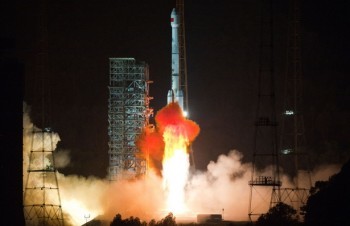.

A super-secretive satellite was launched by China from the Xichang Satellite Launch Center on Saturday. Launch of the unknown spacecraft took place at 15:40 UTC using a Long March-3B (Chang Zheng-3B) rocket, as the Chinese continue their military build up in space.There is very little information regarding the satellite. However, rumors circling on specialized Chinese space forums point to this launch involving the first Great Wall (Changcheng) satellite – a new series of Chinese satellites dedicated to early warning similar to the American Space Based Infra-Red Sensor satellites.
Recently, Japan’s Kyodo News reported that China was building a missile defense system to detect a ballistic missile attack. The report was based on Chinese military documents that referred the development of an experimental early warning satellite program.
Additionally the report pointed out that China had started the development of an X-band radar system as part of a ground-based interceptor system.
Launch vehicle and launch site:
Developed from the Chang Zheng-3A, the Chang Zheng-3B is the most powerful launch vehicle on the Chinese space launch fleet.
The CZ-3B features enlarged launch propellant tanks, improved computer systems, a larger 4.2 meter diameter payload fairing and the addition of four strap-on boosters in the core stage that provide additional help during the first phase of the launch.
The rocket is capable of launching an 11,200 kg satellite to a low Earth orbit or a 5,100 kg cargo to a geosynchronous transfer orbit.
The CZ-3B/G2 (Enhanced Version) launch vehicle was developed from the CZ-3B, increasing the GTO capacity up to 5,500kg.
On May 14, 2007, the first flight of CZ-3B/G2 was performed successfully, accurately sending the NigcomSat-1 into pre-determined orbit. With the GTO launch capability of 5,500kg, CZ-3B/G2 is dedicated for launching heavy GEO communications satellite.
The rocket structure also combines all sub-systems together and is composed of four strap-on boosters, a first stage, a second stage, a third stage and payload fairing.
The first two stages – as well as the four strap-on boosters – use hypergolic (N2O4/UDMH) fuel while the third stage uses cryogenic (LOX/LH2) fuel. The total length of the CZ-3B is 54.838 meters, with a diameter of 3.35 meters on the core stage and 3.00 meters on the third stage.
On the first stage, the CZ-3B uses a YF-21C engine with a 2,961.6 kN thrust and a specific impulse of 2,556.5 Ns/kg. The first stage diameter is 3.35 m and the stage length is 23.272 m.
Each strap-on booster is equipped with a YF-25 engine with a 740.4 kN thrust and a specific impulse of 2,556.2 Ns/kg. The strap-on booster diameter is 2.25 m and the strap-on booster length is 15.326 m.
The second stage is equipped with a YF-24E (main engine – 742 kN / 2,922.57 Ns/kg; four vernier engines – 47.1 kN / 2,910.5 Ns/kg each). The second stage diameter is 3.35 m and the stage length is 12.920 m.
The third stage is equipped with a YF-75 engine developing 167.17 kN and with a specific impulse of 4,295 Ns/kg. The fairing diameter of the CZ-3B is 4.00 meters and has a length of 9.56 meters.
The CZ-3B can also use the new Yuanzheng-1 (“Expedition-1″) upper stage that uses a small thrust 6.5 kN engine burning UDMH/N2O4 with a specific impulse at 3,092 m/s. The upper stage is able to conduct two burns, having a 6.5 hour lifetime and is capable of achieving a variety of orbits. This upper stage was not used on this launch.
The Xichang Satellite Launch Centre is situated in the Sichuan Province, south-western China and is the country’s launch site for geosynchronous orbital launches.
Equipped with two launch pads (LC2 and LC3), the centre has a dedicated railway and highway lead directly to the launch site.
The Command and Control Centre is located seven kilometers south-west of the launch pad, providing flight and safety control during launch rehearsal and launch.
The CZ-3B launch pad is located at 28.25 deg. N – 102.02 deg. E and at an elevation of 1,825 meters.
Other facilities on the Xichang Satellite Launch Centre are the Launch Control Centre, propellant fuelling systems, communications systems for launch command, telephone and data communications for users, and support equipment for meteorological monitoring and forecasting.
The first launch from Xichang took place at 12:25UTC on January 29, 1984 when the Chang Zheng-3 (CZ3-1) was launched the Shiyan Weixing (14670 1984-008A) communications satellite into orbit.
Quelle: NS
4443 Views
